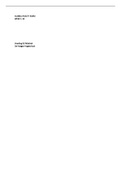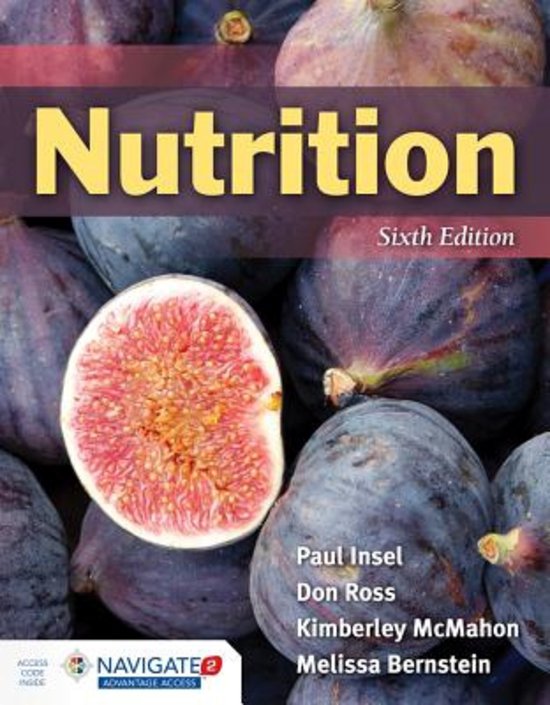GLOBAL HEALTH EXAM
WEEK 1-19
Voeding & Diëtetiek
De Haagse Hogeschool
, Literatuur/ voorbereiding:
EAT-lancet report – summary
the EAT-Lancet Commission on Healthy Diets from
Sustainable Food Systems: The Commission focuses in two
selections, which are: “end-points” of the global food system:
final consumption (healthy diets) and production (sustainable
food production). These factors disproportionately impact
human health and environmental sustainability.
© How food is produced, what is consumed, and how much is lost or wasted all heavily
shape the health of both people and planet.
© Great Food Transformation. The Commission calls for widespread multi-sector, multi-
level action including: a substantial global shift toward healthy dietary patterns; large
reductions in food loss and waste; and major improvements in food production
practices. The data are both sufficient and strong enough to warrant immediate
action.
© Most studies concluding that a diet rich in plant-based foods and with fewer animal
source foods confers both improved health and environmental benefits. Overall, the
literature indicates that such diets are “win-win” in that they are good for both
people and planet.
© The boundaries of the safe operating space are placed at the lower end of the
scientific uncertainty range, establishing a "safe space" which, if transgressed, would
push humanity into an uncertainty zone of rising risks. Operating outside this space
for any Earth system process (e.g., high rates of biodiversity loss) or food group (e.g.,
insufficient vegetable intake) increases the risk of harm to the stability of the Earth
system and human health.
© These dietary patterns can be “healthy and unsustainable” (win-lose), “unhealthy and
sustainable” (losewin), “unhealthy and unsustainable” (lose-lose) and “healthy and
sustainable” (win-win).
Setting Scientific Targets for Healthy Diets and Sustainable Food
Production:
© Healthy diets: A healthy diet should optimize health, defined
broadly as being a state of complete physical, mental and social
well-being and not merely the absence of disease.
A planetary health plate should consist by: - volume of
approximately half a plate of vegetables and fruits; the other half
should consist of primarily whole grains, plant protein sources,
unsaturated plant oils, and (optionally) modest amounts of
animal sources of protein.
© The “diet gap” between current dietary patterns and intakes of
food in the planetary health diet:
, © What Is a Food System?
The UN’s Food and Agriculture Organization (FAO) defines food system as encompassing
all the stages of keeping people fed: growing, harvesting, packing, processing, transporting,
marketing, consuming, and disposing of food. But it’s not just one system—it’s systems
within systems. It’s ecosystems, agricultural systems, processing systems, transportation
systems, marketing systems, and much more. It’s the interconnected web of resources,
activities, and people and the decisions that they make that gets food to your table.
© Generally speaking, the greatest environmental benefit can be achieved by wasting less food;
eating less meat and more sources of plant-based proteins, such as pulses and nuts; only
eating what you need; replacing alcohol, fruit juices and soft drinks with tap water, tea and/or
coffee.
Five Strategies for a Great Food Transformation
x Seek international and national commitment to shift toward healthy diet:
Increased consumption of plant-based foods – including fruits, vegetables, nuts, seeds and
whole grains – while in many settings substantially limiting animal source foods. This
concerted commitment can be achieved by making healthy foods more available, accessible
and affordable in place of unhealthier alternatives, improving information and food
marketing, investing in public health information and sustainability education, implementing
food-based dietary guidelines, and using health care services to deliver dietary advice and
interventions.
x Reorient agricultural priorities from producing high quantities of food to producing healthy
food: Agriculture and fisheries must not only produce enough calories to feed a growing
global population but must also produce a diversity of foods that nurture human health and
support environmental sustainability.
x Sustainably intensify food production to increase high-quality output:
The current global food system requires a new agricultural revolution that is based on
sustainable intensification and driven by sustainability and system innovation. This would
entail at least a 75% reduction of yield gaps on current cropland, radical improvements in
fertilizer and water use efficiency, etc.
, x Strong and coordinated governance of land and ocean:
This implies feeding humanity on existing agricultural land i.e., by implementing a zero-
expansion policy of new agricultural land into natural ecosystems and species-rich forests,
aiming management policies at restoring and reforesting degraded land, establishing
international land use governance mechanisms, and adopting a "Half Earth" strategy for
biodiversity conservation and improving the management of the worlds ocean.
x At least halve food losses and waste, in line with UN Sustainable Development Goals:
Substantially reducing food losses at the production side and food waste at the consumption
side is essential for the global food system to stay within a safe operating space. Actions
include improving post-harvest infrastructure, food transport, processing and packing,
increasing collaboration along the supply chain, training and equipping producers, and
educating consumers.
Generally speaking, the greatest environmental benefit can be achieved by:
x wasting less food;
x eating less meat and more sources of plant-based proteins, such as pulses and nuts.
x only eating what you need.
x replacing alcohol, fruit juices and soft drinks with tap water, tea and/or coffee.
This advice is in line with previous guidance from the Health Council on a sustainable, healthy diet.
Solutions to combat waste and promote sustainable food are three things:
x optimise the management and use of resources such as soil,
water, biodiversity and minerals (nitrogen and phosphorus).
x stop wasting food.
x promote the utilisation of waste.
How do you measure sustainability? The environmental impact of
diets can be measured using a number of different indicators. The
choice of indicator depends on the level you are looking at. You can
look at individual or national diets, for example, or at the product
level. The most studied and most commonly used indicators at the
national level are the ecological footprint, carbon footprint, water
footprint and energy footprint.






